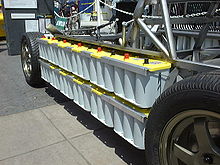VRLA accumulator

A VRLA battery ( engl. V alveolar r egulated l EAD a cid battery "valve-regulated lead-acid battery") is a lead-acid battery in a sealed design. The accumulator contains a pressure relief valve .
features
Common features of sealed lead-acid batteries are:
- The cells are welded shut, there is only a pressure relief valve.
- The electrolyte is thickened, i.e. no longer liquid, making it possible to operate sealed lead-acid batteries permanently in the side position, but only if the plate sets are arranged vertically in order to absorb the recombined water. Due to the capillary effect, the electrolyte saturation level of the upper layers is not guaranteed when the plate sets are in a horizontal position. Due to the safety valves, lead-acid batteries cannot be operated permanently "overhead", since then dripping amounts of the electrolyte would be possible. Temporary operation or storage in unusual locations is not critical, which is why sending mail or turning devices such as lawnmowers around for maintenance work is not a problem.
- In the case of conventional lead-acid batteries, the individual cells must be regularly refilled with distilled water during maintenance, which evaporates in the course of gassing or heating and also changes the acid concentration. This is not possible and also not necessary when the accumulators are closed.
- Sealed lead-acid batteries emit significantly less gas than conventional ones: gas channels form through the fixed electrolyte. The oxygen formed by the side reaction on the positive electrode can therefore migrate directly to the negative electrode and recombine there to form water.
- If a sealed lead-acid battery is overcharged, for example if the charge regulator is defective, an excess of oxygen is generated that can no longer recombine. Hydrogen is generated to the same extent at the negative electrode. Since it is not possible to refill the electrolyte, sealed lead-acid batteries require an adapted charging process . It must be avoided that the accumulator is charged over a longer period of time at a voltage that is too high, which is associated with strong gassing. In this case the gases escape through the pressure relief valve and the accumulator can dry out over time; the gases that have escaped through the safety valves can no longer be recombined. The valves have a directional effect and do not allow any ventilation or return of media. The use of catalytically active material never takes place inside an accumulator and is only possible in openly ventilated systems, it is then used for gas drying in order to avoid external wetting.
- When charging with excessive voltage, there is a risk of thermal runaway when the lead-acid batteries are closed : The internal oxygen circuit heats the battery. An increase in the battery temperature leads to an increased charging current at constant voltage. This leads to increased gas development and the oxygen cycle is strengthened. This self-reinforcing process can overheat and destroy the accumulator.
Gel accumulator
A gel accumulator is a type of lead accumulator in which the electrolyte (liquid sulfuric acid) is bound by adding silica (hence also often: silicon gel accumulator). Because this type of accumulator is completely closed, it is not possible to top up with water. This type of construction is also referred to as an SLA accumulator (SLA = sealed lead acid ).
Specific properties of gel accumulators:
- There is practically no acid stratification that would otherwise cause a relevant loss of capacity through segregation, with denser acid at the bottom and thinner at the top. In fleece accumulators it is at least reduced compared to standard accumulators with liquid or unbound electrolyte.
- The internal resistance of gel lead accumulators is higher than that of comparable non-sealed lead accumulators. They are therefore less suitable for delivering high currents, as are required when used as a starter battery. Gel accumulators are, however, available for motorcycles, scooters and similar vehicles precisely because of their closed design.
Absorbent Glass Mat (AGM)
Absorbent Glass Mat (AGM) is another type of lead accumulator in which the electrolyte is bound in a nonwoven made of glass fiber . The common name on the market for this is VRLA-AGM.
Fleece accumulators can deliver currents that are at least as high as open versions and are used, for example, as starter batteries in motorcycles, boats (no acid leaks when tipping or capsizing), vehicles with a start-stop system or electric vehicles (e.g. in the CityEL ) . These accumulators are also increasingly used in car hi-fi applications. There you make use of the lower internal resistance (compared to wet accumulators).
Leading manufacturers in the field of high starting currents for applications in motor vehicles include Johnson Controls (e.g. in Hanover), Exide and Banner batteries .
literature
- Jiujun Zhang, Lei Zhang, Hansan Liu, Andy Sun, Ru-Shi Liu (eds.): Electrochemical technologies for energy storage and conversion. Wiley, Weinheim 2012, pp. 143-146.
- Chapter 17: Kathryn R. Bullock, Alvin J. Salkind: Valve Regulated Lead-Acid Bätteries. In: Thomas B. Reddy (Ed.): Linden's Handbook of Batteries. 4th edition. McGraw-Hill, New York 2011, ISBN 978-0-07-162421-3
Individual evidence
- ↑ A standard accumulator with a capacity of 50 Ah can usually deliver a cold start current of 350 to 450 A. AGM accumulators can provide a cold start current of up to 800 A with the same capacity (depending on the manufacturer and design).
- ↑ Johnson Controls increases battery production in Hanover , February 8, 2016

